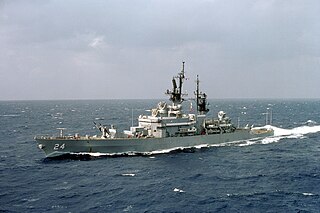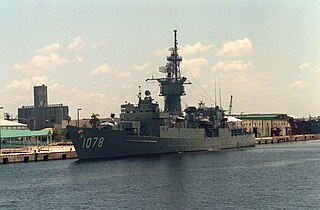
USS Long Beach (CLGN-160/CGN-160/CGN-9) was a nuclear-powered guided missile cruiser in the United States Navy and the world's first nuclear-powered surface combatant. She was the third Navy ship named after the city of Long Beach, California.

USS Reeves (DLG/CG-24), a United States Navy ship named after Admiral Joseph Mason Reeves, was a Leahy-class cruiser built by the Puget Sound Naval Shipyard, in Bremerton, Washington.

USS Oliver Hazard Perry (FFG-7) was the lead ship of the Oliver Hazard Perry class of guided-missile frigates. She was named for Oliver Hazard Perry, an American naval hero who was victorious at the 1813 Battle of Lake Erie. Oliver Hazard Perry (FFG-7) was the first ship and, as of 2019, the only ship of the U.S. Navy to bear the name. Oliver Hazard Perry was in service from 1977 to 1997 and was scrapped in 2005.

USS Dale (DLG-19/CG-19) was a Leahy-class cruiser in service with the United States Navy from 1963 to 1994. She was sunk as a target in 2000 off the East Coast of the United States near Maryland.

The fourth USS Decatur (DD-936) was a Forrest Sherman-class destroyer of the United States Navy in service from 1956 to 1983. She was named for Commodore Stephen Decatur USN (1779–1820). Decatur was modernised as a guided missile destroyer in the mid-1960s and re-designated DDG-31. After her decommissioning in 1983, she operated as the U.S. Navy's Self Defense Test Ship from 1994 to 2003. She was finally sunk as a target the following year.

USS Arleigh Burke (DDG-51), named for Admiral Arleigh A. Burke, USN (1901–1996), is the lead ship of the Arleigh Burke-class guided-missile destroyers. She was laid down by the Bath Iron Works company at Bath, Maine, on 6 December 1988; launched on 16 September 1989; and commissioned on 4 July 1991.

USS Belknap (DLG-26/CG-26), named for Rear Admirals George E. Belknap (1832–1903) and his son Reginald Rowan Belknap (1871–1959), was the lead ship of her class of guided missile cruisers in the United States Navy. She was launched in 1963 as DLG-26, a guided missile frigate under the then-current designation system, and reclassified as CG-26 on 30 June 1975.

The 18 Forrest Sherman-class destroyers comprised the first post-war class of US destroyers. Commissioned beginning in 1955, these ships served until the late 1980s. Their weaponry underwent considerable modification during their years of service. Four were converted to guided-missile destroyers. This class also served as the basis for the Charles F. Adams-class guided-missile destroyers.

USS Newport News (CA–148) was the third and last ship of the Des Moines-class of heavy cruisers in the United States Navy. She was the first fully air-conditioned surface ship and the last active all-gun heavy cruiser in the United States Navy.

USS Oklahoma City (CL-91/CLG-5/CG-5) was one of 27 United States Navy Cleveland-class light cruisers completed during or shortly after World War II, and one of six to be converted to guided missile cruisers. She was the first US Navy ship to be named for Oklahoma City, Oklahoma. Commissioned in late 1944, she participated in the latter part of the Pacific War in anti-aircraft screening and shore bombardment roles, for which she earned two battle stars. She then served a brief stint with the occupation force. Like all but one of her sister ships, she was retired in the post-war defense cutbacks, becoming part of the Pacific Reserve Fleet in 1947.

USS Okinawa (LPH–3) was the second Iwo Jima-class amphibious assault ship of the United States Navy. She was the second Navy ship assigned the name "Okinawa", in honor of the World War II Battle of Okinawa.

USS Sacramento (AOE-1) was the third ship in the United States Navy to bear the name, for both the river, and the capital city of California. She was the lead ship of her class of fast combat support ship.

USS Harry E. Yarnell (DLG/CG-17) was a Leahy-class guided missile cruiser of the United States Navy. Named in honor of Admiral Harry E. Yarnell,, she was originally classified as a "destroyer leader" or frigate, in 1975 she was redesignated a cruiser in the Navy's ship reclassification. She was the second of the "double-end" Leahy-class guided missile frigates to join the fleet.

USS California (CGN-36), the lead ship of the California-class of nuclear-powered guided missile cruisers, was the sixth warship of the United States Navy to be named for the state of California. She was the last active nuclear-powered cruiser for the United States.

USS Richmond K. Turner was a Leahy-class cruiser destroyer leader in the United States Navy. The ship was named for Admiral Richmond K. Turner, who served during World War II.

ROCS Lan Yang (FFG-935) is a Chi Yang-class frigate of the Republic of China Navy. She was formerly in service as the USS Joseph Hewes (FF-1078), a Knox-class frigate of the United States Navy.

USS Hyades (AF-28) was the lead ship of her class of stores ships acquired by the U.S. Navy for service in World War II. Her task was to carry stores, refrigerated items, and equipment to ships in the fleet and to remote stations and staging areas.

Carrier Air Wing Six (CVW-6) was a United States Navy aircraft carrier air wing whose operational history spans from the middle of World War II to the end of the Cold War. Established in 1943 as Carrier Air Group Seventeen (CVG-17), it would be re-designated several times during its establishment, including Carrier Air Group Six (CVG-6) as the second unit to be so designated. The first Carrier Air Group Six served for just over two years during World War II, but drew on the history of the Enterprise Air Group established in 1938 and active in the early battles of the Pacific War, being disestablished after the first year of the conflict. During its time in USS Enterprise (CV-6), it was the Navy's only carrier-based air group to carry out three complete tours of duty during World War II.





















